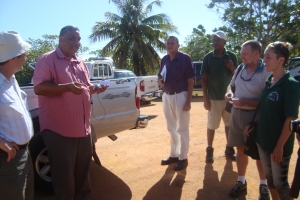Coastal Development and Ecosystem Modelling
A tool for Improved Local and National Policy Decision Making Processes in the Seychelles.
Location: Seychelles. 19th Mar 2012
The project which started in August 2010 is being implemented by the Marine Conservation Society, Seychelles (MCSS) and the Green Islands Foundation (GIF), funded by Mangroves for the Future with financial support from NORAD and SIDA. The International Union for the Conservation of Nature and Natural Resources, IUCN, provides management support and oversight to the project.. Four pilot sites were chosen to represent different levels of coastal development for this project; Beau Vallon Bay (highly developed); Intendance (moderately developed); North Island (eco-managed small granitic island) and Denis Island (eco-managed small coral island). The two island sites are also co-financing the project as local implementers and partners.
Several in-depth assessments and data have been gathered on the four sites during the initial stages of the project establishing baseline information on factors such as water and soil quality, number and types of buildings and species assemblages enabling the grantees to fully identify and understand the extent of development impact on the coastal areas on different coastal scenarios and allowing for comparison of the results of each project site.
Another major step into the project by the grantees and partners such as DOE, MLUH, Department of Community Development is meetings held with District administrators and some informal sessions with community members informing them of the ultimate benefit of the project outputs in empowering the local community to take part in coastal development decisions as they become adequately aware of development plans thus can share responsibility in managing coastal areas in their districts. A workshop was held with school children guiding their understanding of the concept of sustainable coastal development after which they conducted further research for a public speaking competition conveying information, as well as their own personal feelings on the subject to their communities through the national television network, SBC. Students highlighted the positive and negative features of coastal development for wildlife and people, with typical examples from around Seychelles.
The results of the pilot site assessments and results will soon be presented at public meetings being planned with the relevant DAs and shared with the local communities so they know of and better understand the critical habitat and biodiversity of the coastal areas in their districts. The project partners strongly advise members of the community to participate in the meetings:
Why is it important to participate in the public meeting?
- You will learn to find the balance between coastal development and biodiversity conservation in your coastal area.
- You will discover potential biodiversity value in your community.
- You will be guided about your share of responsibilities in coastal development in your community and how to participate effectively in the coastal development processes and make your voice heard.
- You will find out that your participation and contribution in EIA meetings can largely influence development perspectives and keep you on the lookout for sustainable practices in your community.
MCSS and GIF together with other partners from the Department of Environment, the Ministry of Land Use and Habitat, the Ministry responsible for Community Development are working together to help you play a vital role in the coastal development processes in your community. They want to do away with the perception that projects have already been approved by the time EIA public meetings are held in the community. Remember that you are at the centre of development in your community; you can influence the course of development projects given proven knowledge of impacts, positive or negative, on different aspects of their community assets.

LP grantees consult with district authority, Takamaka, Sez © L. Bastienne MFF Sez, 2012